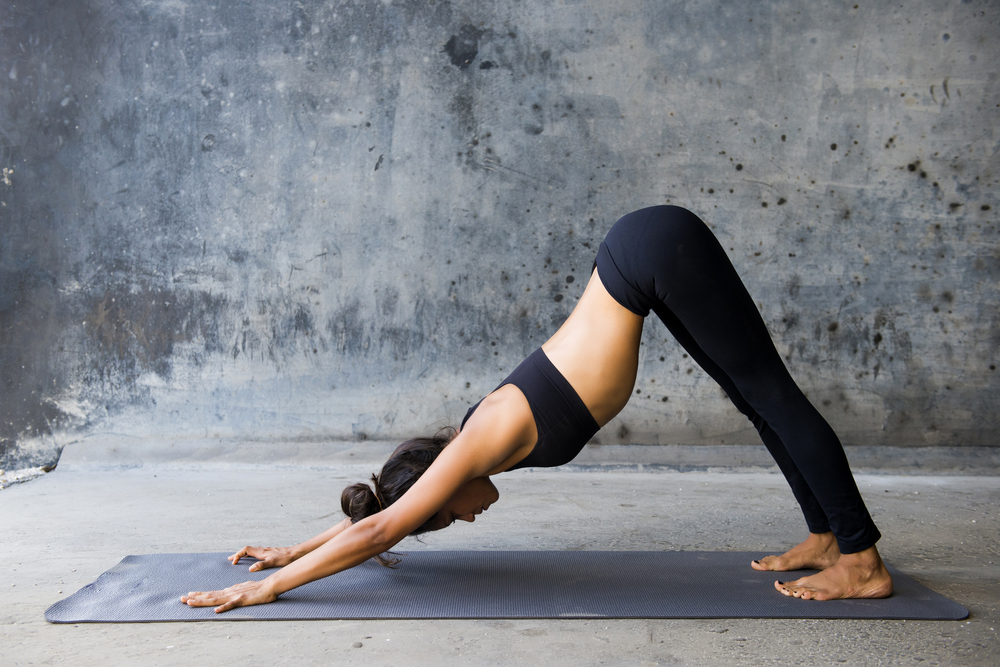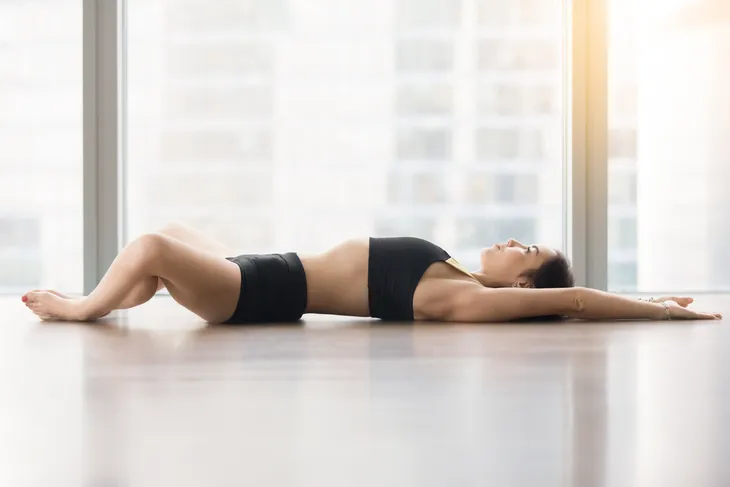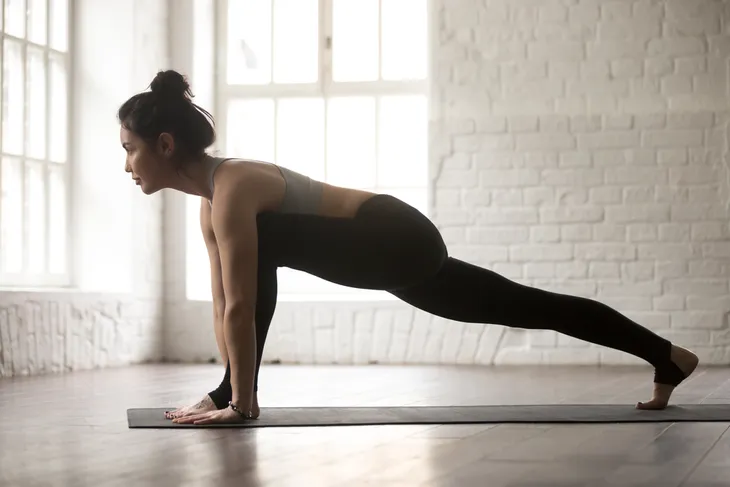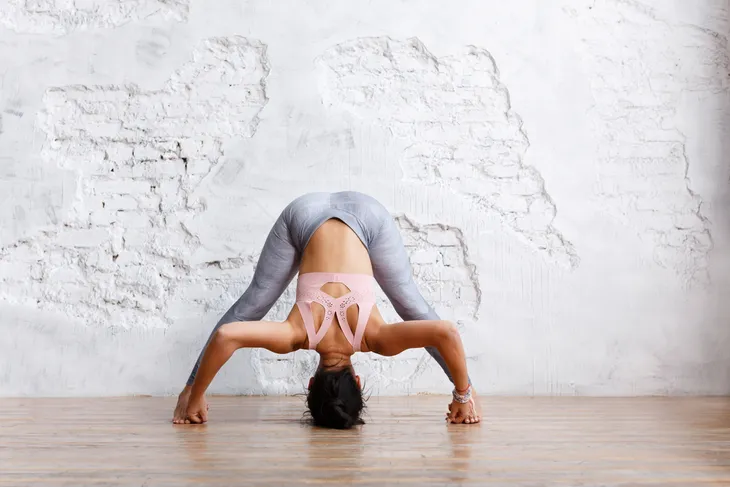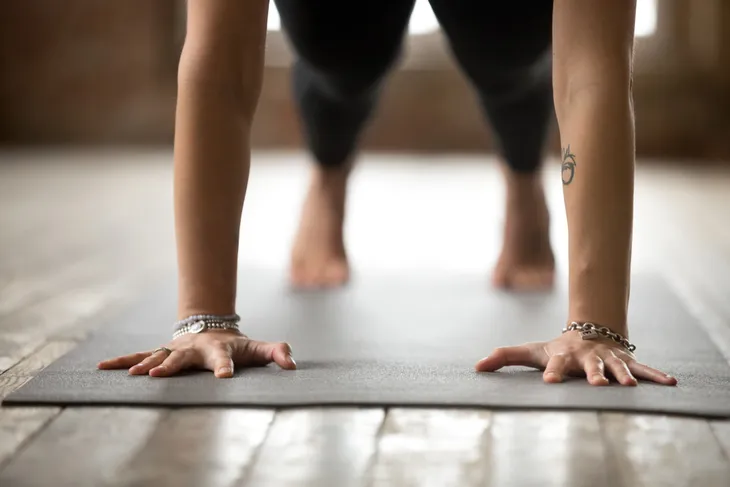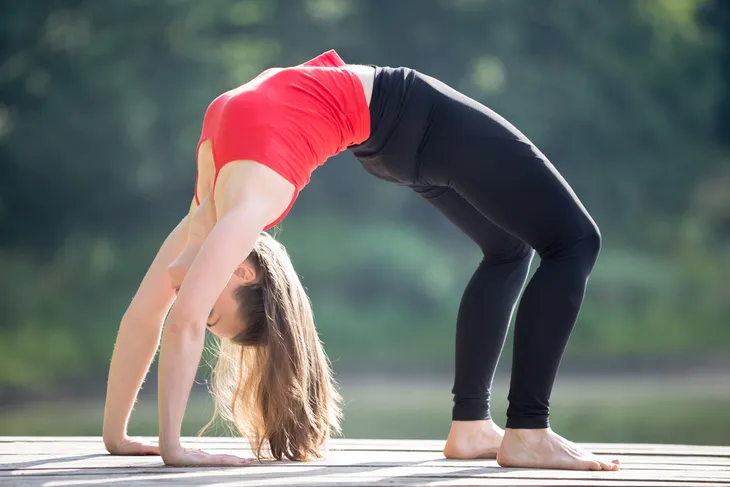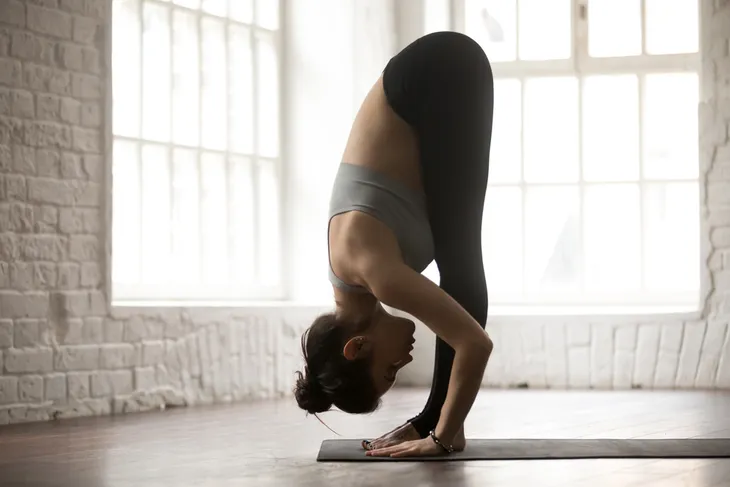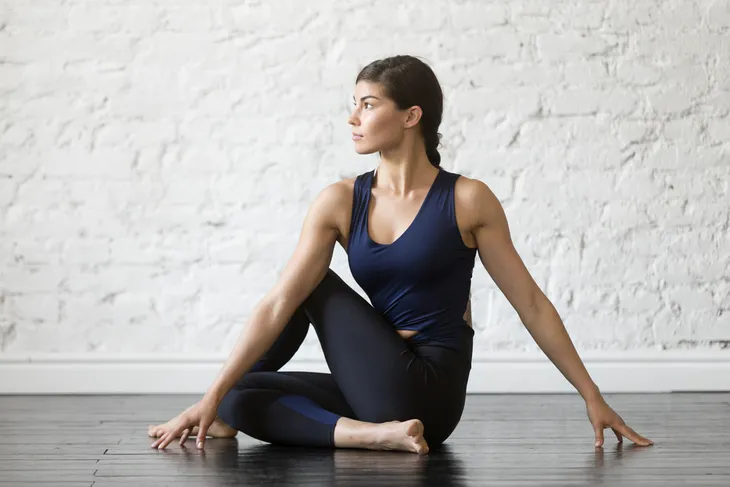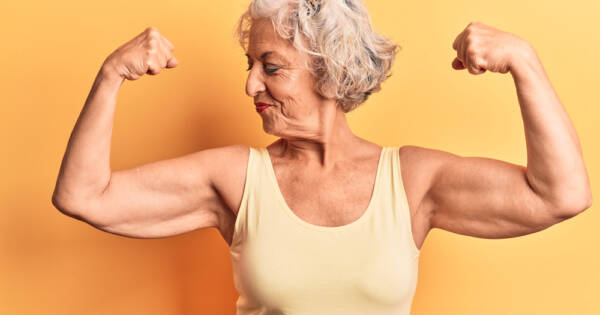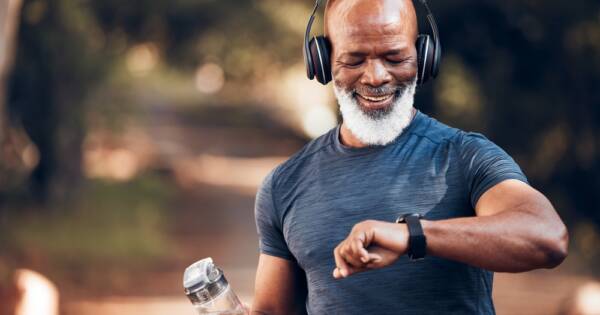If your body is as flexible as your day—not at all—the following yoga poses will ensure a good stretch to several large muscle groups (i.e., like the hamstrings, back, legs, and hips) while strengthening the legs and core.
Incorporate these ten multi-muscle yoga poses into days when you have limited time…
Bound Angle
Bound angle pose (or Baddha Konasana) accomplishes a lot more than meets the eye. In addition to providing a deep stretch to the areas of the groin and inner thighs, this pose improves flexibility in the knees, soothes menstrual and sciatic pain, and stimulates circulation.
Baddha Konasana destroys disease and gets rid of fatigue. To perform bound angle pose:
- Sit on the floor with your legs extended straight out in front.
- Bend your knees, (as if sitting cross legged), but bring the soles of your feet together.
- Your knees may or may not touch the ground.
- Sit up straight, shining your chest upward and hinge forward from the hips as you exhale, bringing your chest towards your feet.
- Try not to round down with your spine as you sit comfortably with your hands on your feet or palms flat on the ground in front of your feet.
Standing Side Bend
The tendency to head front-on into life has us often neglecting the muscles in the side of our bodies. Standing side bend (or Parsva Tadasana) helps us explore, open, and breathe into our side bodies to create space and flexibility. To perform standing side bend:
- Start standing straight in mountain pose (or Malasana).
- Interlace your fingers with palms facing up and reach to the right as you bend from the waist lengthening your side body.
- Return to standing and repeat on the left side.
Runner’s Lunge
Runner’s lunge (also called high lunge or Ashva Sanchalanasana by some yoga schools) provides a wonderful stretch to the groin, hips, legs and arms. To perform runner’s lunge:
- From downward dog (or Adho Mukha Svanasana) bend your right knee and step your right foot forward between your hands
- In a lunge position, placing your hands, fingertips on the floor, under the shoulders on either side of your foot (or use blocks if your hands don’t reach).
- Return to the downward facing dog and switch sides.
Downward-Facing Dog
Not only is downward-facing dog a killer stretch for the arms, hands, legs, hamstrings, glutes, claves, hips, shoulders, feet, and low back, Adho Mukha Svanasana is an energizing pose that relieves stress, fatigue, and even high blood pressure. To perform down dog:
- Come into tabletop position, onto hands (flat palms) and knees with back flat (hands below shoulders and knees below hips).
- Turn your toes under and press back as you lift up through your knees.
- Keeping the knees slightly bent (the heels may not reach the floor), lengthen through the tailbone, pressing the pelvis lightly forward so the sitting bones shine up towards the ceiling.
- Turning your inner thighs inward and square the pelvis as you reach your heels stretch your heels toward the floor (but don’t lock the knees). You should feel a nice stretch to the hamstrings.
- For a firm foundation, press down through the hands so the index fingers and thumbs are planted into the floor.
- Let go of tension in the neck and shoulders as you let the shoulder blades widen and relax, sliding down the spine.
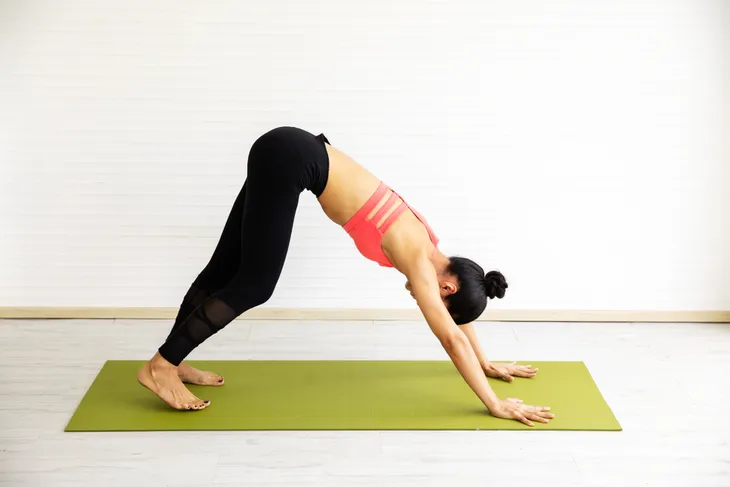
Extended Side Angle
Not many poses permit a full body stretch like extended side angle (or Utthita Parsvakonasana. This pose stretches the spine, shoulders, groin, back, spine, and waist in a deep twist while lengthening the hips and thighs and strengthening the legs, knees, and ankles. It’s like a nice massage for your abdominal organs. To perform extended side angle:
- From Mountain Pose come into a high lunge with your right foot, bend at the right knee so the foot is planted directly under.
- Your left food should turn out 90 degrees with heels perfectly aligned. Don’t overextend the knee.
- Grounding through the back heel, twist to the left using the core, the left elbow and torso should rest lightly against your right outer thigh or you can place your fingertips or palm flat beside the inner foot.
- To come back to neutral, untwist and press though the heels to straighten the legs and arms.
- Repeat on the opposite side.
Wide-Legged Forward Bend
This triangle-shaped stretch creates space in the backs of the legs, chest, shoulders, and lower back, strengthening the inner thighs, back legs, and spine. Prasarita Padottanasana is another great massage for the abdominal organs. It even soothes headaches. To perform wide-legged forward bend:
- Coming into mountain pose (or Tadasana), step your feet apart roughly 4-feet in distance. With your hands on your hips and feet parallel.
- Engage the thigh muscles, lift the chest forward to lengthen and bend forward from the hip joints.
- Press your fingertips onto the floor, hands sitting directly below the shoulders, elbows extended and neck and torso lengthened.
- You can even rest the crown of your head on the floor.
- To exit the pose, place hands below your shoulders, lengthen the torso, place your hands on your hips and come up one vertebra at a time, walking your feet back together.
Plank
To strengthen and stretch the abdominals, arms, wrists, upper back, butt, and spine, planks work wonders. To perform plank pose:
- Come into a push up pose with your hands planted firmly on the floor, positioned directly under your shoulders, and balancing on the toes.
- Your spine and butt should form a straight line as you press up through the thighs and lengthen your tailbone toward the heels.
- Elongate the neck, looking ahead at the floor.
Wheel
A fantastic chest and lung opener as well as providing a fine stretch for the thighs, glutes, arms, abdomen, and spine, wheel pose (or Urdhva Dhanurasana) lessens the symptoms of asthma and thyroid conditions. To perform wheel pose:
- Lie flat on your back on the floor with legs extended and arms at your sides.
- Bend your knees with feet flat on the floor and scoot your heels as close to your buttocks as possible.
- Bend your elbows up so they are facing the ceiling (forearms should be perpendicular to the floor) as you spread your palms on the floor beside your head with fingers aimed at your shoulders.
- Pressing through the feet and inner thighs, raise your buttocks and tailbone up, but don’t firm the buttocks, keeping your thighs and feet parallel (under the hips).
- Press through the palms, feet, and thighs, keeping your shoulder blades flat against your back as you straighten your arms and lifting through the crown of your head and lifting the pubis toward the navel so that your back arches and your body forms a wheel.
- Loosen the tension in your neck so the head hangs comfortably.
- Take your time to come out of this pose safely and gradually.
Standing Forward Bend
A standing forward bend/hang will do wonders for tight hamstrings, calves, and hips while strengthening the knees and thighs. This pose combats fatigue, anxiety, and soothes headaches and insomnia. To perform a standing forward bend:
- Take mountain pose with your feet hip-distance apart, don’t lock your knees.
- Interlace your fingers behind your back, palms up (or use a strap), straightening the arms and expanding the chest.
- Exhale and bend forward at the waist, stretching your hands toward the ceiling or your head.
- Alternately, you can place your palms or fingertips on the floor beside your feet, or hug the elbows and let your head hang loose.
Seated Twist
A seated twist, or more precisely, Ardha Matsyendrasana, benefits multiple muscles and joints—like the neck, shoulders, hips, and spine—while it stimulates the digestive system, eases back issues (i.e., sciatica) and tummy discomfort (i.e., indigestion and menstrual cramps). To perform Ardha Matsyendrasana:
- Sit on the floor with your legs extended straight out in front.
- Bend your right knee and place your right foot over your bent left leg.
- Place your right palm on the floor behind you, fingers pointing away from your buttocks.
- Twist to the right, bending the left elbow and hugging the back of the left arm against your right knee. Gaze over your right shoulder.
- Extend your spine as you inhale and twist more deeply during the exhale.
- Untwist and repeat on the opposite side.
